Mastering the Art of Baking Cupcakes
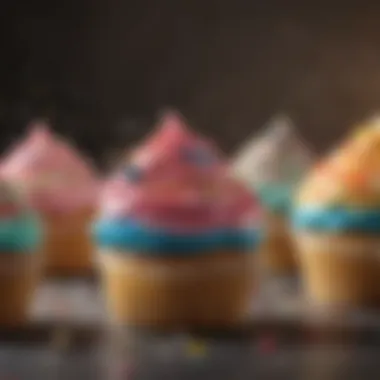
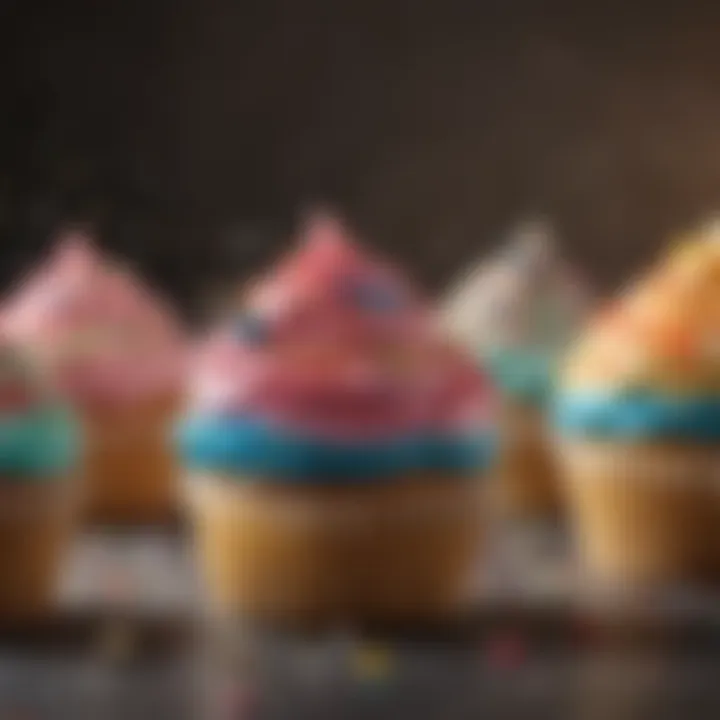
Intro
Baking cupcakes is more than just mixing together flour, sugar, and eggs. It’s a delightful form of artistry that tells stories through its flavors, textures, and even its presentation. Whether you’re prepping for a birthday, a wedding, or just a Saturday afternoon treat, understanding the fundamentals of cupcake baking allows for endless creativity and joy.
In this guide, we will embark on a journey through the essentials of baking cupcakes, from selecting the right ingredients to mastering various techniques that cater to time constraints and dietary considerations. So, roll up your sleeves, embrace your inner baker, and let’s get into the rich, delectable world of cupcakes.
Recipe Overview
Yummy Chocolate Delight Cupcakes
- Portions: 12 cupcakes
- Prep Time: 20 minutes
- Cook Time: 15 minutes
- Difficulty: Easy
- Main Ingredients:
- All-purpose flour
- Unsweetened cocoa powder
- Baking powder
- Granulated sugar
- Eggs
- Milk
- Vanilla extract
- Butter
When it comes to cupcake recipes, the classic chocolate option is a sure-fire crowd-pleaser. The rich flavors and soft texture are just a match made in heaven for any event or casual gathering.
Step-by-Step Instructions
- Prep the Ingredients:
Start by preheating your oven to 350°F (175°C). Line a muffin tin with cupcake liners. In a bowl, whisk together the flour, cocoa powder, baking powder, and sugar. In another bowl, beat the eggs and mix in the milk and vanilla extract. Melt the butter, letting it cool slightly, then add it to the mixture. - Combine Wet and Dry Ingredients:
Gradually combine the dry ingredients into the wet ingredients until just mixed. Be careful not to overmix; it’s okay to have a few lumps. - Fill and Bake:
Pour the batter into the prepared liners, filling each one about 2/3 full. Bake for about 15 minutes or until a toothpick comes out clean when inserted. - Cooling:
After removing from the oven, let them cool in the tray for 5 minutes; then, transfer them to a wire rack to cool completely before frosting.
Time-Saving Strategies
- Batch Cooking: Consider making a double batch and freezing extra cupcakes; just be sure to wrap them well to maintain freshness.
- Ready-Made Frosting: If time is of the essence, explore options for store-bought frosting that still allows you to add your personal touch by mixing in flavors or toppings.
Nutritional Information
Per cupcake, you can expect:
- Calories: ~210
- Proteins: 3g
- Fats: 8g
- Carbohydrates: 32g
These tasty treats also offer a bit of fiber from the cocoa and a nice dose of energy from the sugars. Chocolate isn’t just a treat; it also contains beneficial antioxidants.
Quick Cooking Tips
- Use a Hand Mixer: This speeds up the process and ensures a smooth batter without much elbow grease.
- Muffin Tins: While you can get fancy with specialty pans, a traditional muffin tin works just as great for baking cupcakes.
- On-the-Fly Alternatives: If you're out of milk, opting for a milk substitute like almond or soy can yield great results without sacrificing flavor.
Related Recipes & Variations
If chocolate cupcakes aren’t your thing, consider branching out:
- Vanilla Bean Cupcakes: Simple yet elegant, perfect for any occasion.
- Lemon Zest Cupcakes: Bringing a refreshing twist to your dessert table.
- Gluten-Free Options: Substitute all-purpose flour with almond or coconut flour for an allergy-friendly treat.
Encouraging your own variations is key! Experiment with different fillings, icings, and toppings, and don’t hesitate to share your unique cupcake creations. Remember, the sky's the limit when it comes to creativity in the kitchen.
"The joy of baking is in its experimentation; don’t shy away from turning a classic recipe into your own masterpiece."
With these insights, you’re now equipped to dive into the world of cupcake baking with confidence!
Preface to Cupcake Baking
Cupcake baking stands as a delightful intersection of art and science, offering an accessible way for both novices and seasoned bakers to express their creativity. Elegant in theory yet approachable in practice, baking cupcakes is not merely about mixing flour and sugar—it's a journey through textures, flavors, and presentations that can define any occasion.
The significance of understanding the nuances of cupcake baking lies in its multifaceted nature. For culinary enthusiasts, this article serves as a foundational resource, dissecting elements such as the importance of ingredient selection and optimizing baking techniques. Additionally, it considers how the simple act of baking can serve many purposes; from satisfying a sweet tooth to celebrating monumental life events. By exploring these dimensions, this guide aims not only to illuminate the basic principles but also to inspire readers to experiment and innovate in their baking endeavors.
The Allure of Cupcakes
Cupcakes have an undeniable charm that transcends age and culture. They come in a myriad of colors and flavors, captivating the eye and palate alike. The allure is partly due to their individual servings, which eliminate the need for slicing and serving, making them perfect for gatherings. A table adorned with an array of cupcakes never fails to elicit smiles and create an atmosphere of festivity.
Moreover, the versatility of cupcakes is stunning. From the classic vanilla and chocolate to bold and daring combinations like red velvet with cream cheese frosting, the possibilities are endless. The customization aspect is where the real magic happens. Decorators can unleash their imagination, turning a simple cupcake into a work of art, making them suitable for any theme or event. The combination of creativity and delicacy is what makes cupcakes a quintessential treat.
Why Bake Cupcakes?
Baking cupcakes offers several compelling benefits that go beyond mere consumption.
- Simplicity in Baking: Unlike larger cakes, cupcakes typically require less time to bake and cool, providing immediate gratification. It’s an ideal choice for those who may lack the patience for intricate dessert preparations.
- Endless Experimentation: The relatively small size allows for experimentation with flavors and toppings without the commitment that larger cakes entail. This makes baking an excellent practice ground for aspiring bakers to hone their skills.
- Sharing Joy: Cupcakes foster a sense of community. Whether it's a birthday party, wedding, or even an office celebration, they are easy to share and distribute, transforming any event into a more joyous occasion.
- Personal Touch: With the ability to personalize each cupcake, they become more than just desserts; they turn into little messages or gifts, often made with the intent to delight others.
"Baking is like love made visible." This sentiment holds true when it comes to cupcakes, as each one holds personal meaning for both the baker and the recipient.
In short, baking cupcakes isn't just about satisfying a craving; it's a fulfilling experience that combines creativity, skill, and emotional resonance. With this section, we set the groundwork for a more in-depth exploration of the cupcake realm, preparing to delve into the essential ingredients that form the backbone of this beloved treat.
Understanding Ingredients
Baking is a precise art that relies on the right ingredients to produce the desired outcome. When it comes to cupcakes, understanding the ingredients isn't just a minor detail; it is the very foundation upon which scrumptious creations are built. Each component plays a vital role, influencing not only the flavor but also the texture, moisture, and overall enjoyment of the final product. By delving into the types of ingredients used in cupcake baking, you’ll equip yourself with the knowledge to craft delightful cupcakes that charm every palate.
Essential Baking Ingredients
Flour Types
Flour is the backbone of any baked good, and cupcakes are no exception. The choice of flour can significantly impact the texture and structure of your cupcakes. Common types include all-purpose, cake flour, and whole wheat flour.
- All-ncll-purpose flour is versatile and suitable for most baking, providing a balanced texture that works well for many cupcake recipes.
- Cake flour, on the other hand, is lower in protein, promoting a tender crumb that many bakers favor for lighter, airier cupcakes.
- Whole wheat flour adds a nutritional punch but can result in a denser texture, which may be desirable for a heartier cupcake.
The key characteristic of flour types lies in their protein content. Higher protein flour leads to more gluten formation, which can create a chewier texture. Cupcake lovers often prefer a delicate crumb, so opting for a low-protein flour can be a wise choice.
Sugars and Sweeteners
Sugar is much more than just a sweetener; it serves multiple roles in cupcake baking. From enhancing flavor to aiding in browning and moisture retention, sugars are crucial. The most commonly used types include granulated sugar, brown sugar, and powdered sugar.
- Granulated sugar is likely the most familiar. It provides sweetness and structure, making it a staple in many recipes.
- Brown sugar contains molasses, which adds moisture and a hint of caramel flavor, ideal for rich cupcake varieties.
- Powdered sugar is often utilized for frosting but can also be incorporated into batter for a creamier texture.
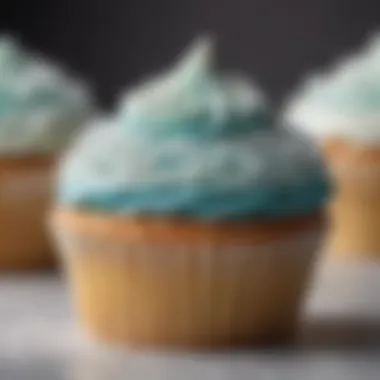

Notably, sugar’s ability to retain moisture can help keep cupcakes fresh and soft. However, using too much can lead to overly sweet or gummy outcomes, so balance is key.
Eggs and Dairy Products
Eggs and dairy products contribute to the richness and moisture that make cupcakes irresistible. Eggs not only bind the batter together but also add air during mixing, contributing to a light and fluffy result. The type of eggs used, whether large or medium, should be considered, as this can affect the proportion of liquid and fat.
Dairy items like milk, cream, or buttermilk enhance moisture and flavor.
- Milk can contribute to a tender, moist crumb, while buttermilk adds tanginess and helps activate leavening agents for a better rise.
Combining these elements, bakers can tailor the texture and flavor profile of their cupcakes to create unique results. The notable aspect here is the interplay between these ingredients and how they harmonize for optimal baking. Striking the right balance of eggs and dairy helps achieve that perfect harmony of moistness without being overly dense.
Special Ingredients for Varied Flavors
Flavor Extracts
Flavor extracts open the door to a world of possibilities in cupcake baking. They allow creators to infuse their batters with distinct flavors that transport the consumer to a new experience. Common options include vanilla, almond, and hazelnut extracts.
The key characteristic of flavor extracts is their concentrated nature; just a small amount can impart significant flavor.
- Vanilla extract is a perennial favorite, beloved for its ability to enhance other flavors—like chocolate or fruit.
- Almond extract brings a nutty sweetness, often surprising bakers with its intensity.
Using flavor extracts provides a way to innovate cupcake recipes beyond the traditional bounds while maintaining the integrity of the texture and structure of the cupcake itself.
Add-ins and Toppings
When it comes to decorating and flavoring cupcakes, the possibilities are nearly endless. Add-ins like chocolate chips or nuts can bring delightful surprises within each bite, while various toppings can elevate the visual and taste appeal.
- Chocolate chips add a layer of decadence and richness, making for a lovely juxtaposition against a lighter cupcake.
- Nuts, such as walnuts or pecans, introduce crunch and extra flavor, but they can also affect the moistness depending on the amount used.
Opting for creative toppings—like sprinkles, fresh fruit, or edible flowers—not only enhances the appearance but can also introduce new textures and flavors. These additions transform ordinary cupcakes into little works of art.
Baking cupcakes is equal parts science and creativity. By understanding the ingredients and their roles, bakers can experiment and innovate, resulting in delightful treats that bring satisfaction to both the maker and the eater.
Detailed Baking Techniques
Baking is as much a science as it is an art, and understanding detailed baking techniques takes your cupcake game to a whole new level. These methods not only affect the flavor and texture of the cupcakes but also influence how they look when served. Mastering various baking techniques ensures that each batch comes out not only delicious but consistently perfect, making you a go-to baker for any occasion. Here we'll dive into specific mixing methods and the crucial variables of baking time and temperature.
Mixing Methods Explained
Mixing methods set the stage for your cupcakes. Understanding the fundamentals of how ingredients come together can greatly impact your results.
Creaming Method
The creaming method is often the foundation for many cupcake recipes. This method involves mixing butter and sugar together until the mixture becomes light and fluffy. This aeration process traps small air pockets, which helps your cupcakes rise beautifully while baking.
One of the key characteristics of the creaming method is that it combines fat with sugar before adding wet ingredients. This initial step is vital; it not only contributes to the texture but also affects the distribution of flavors throughout the batter.
The main advantage of this method is its ability to create a fine crumb structure, yielding cupcakes that are soft yet firm enough to hold intricate decorations. However, it does require that the butter is at the right temperature—room temperature ensures an easier mixing process, while cold butter simply won’t yield the desired fluffiness.
Pros of the Creaming Method:
- Creates a light texture
- Enhances flavor distribution
- Produces uniform cupcakes
Cons of the Creaming Method:
- Requires precise temperature control
- More steps involved than simple methods
One-Bowl Method
On the flip side, the one-bowl method caters to those who prefer simplicity without sacrificing flavor. It’s as straightforward as it sounds: all ingredients are combined in a single bowl and mixed together. This technique has become a popular choice for busy bakers, allowing for speedy cupcake preparation.
The key characteristic of the one-bowl method is convenience. You just toss in the dry ingredients, add the wet ones, and mix until combined. This method is particularly advantageous because it minimizes cleanup, making it a favorite for home bakers.
One notable downside of this approach is that it can sometimes produce denser cupcakes since the ingredients do not have as much time to aerate before the baking process begins. However, with the right recipes, you can achieve moist and flavorful results.
Pros of the One-Bowl Method:
- Quick and easy
- Reduced cleanup time
- Suitable for beginner bakers
Cons of the One-Bowl Method:
- Can lead to denser cupcakes
- May require careful mixing to avoid lumps
Baking Time and Temperature
Once your batter is ready, it’s time to consider baking time and temperature. Both are critical in achieving that perfect cupcake.
General conventions suggest preheating your oven to around 350°F (175°C). A preheated oven ensures that the cupcakes rise properly, creating that beloved dome shape. Keep an eye on your cupcakes starting around the 15-minute mark, as times can vary based on the specific recipe and the oven itself. Once done, a toothpick inserted should come out clean, indicating they’re perfectly baked.
To summarize, developing a solid understanding of mixing methods and appropriate baking temperatures will enhance your baking finesse, leading to superb cupcakes that impress every time. Remember, mastery comes with practice, so keep experimenting and refining your techniques as you dive deeper into the delightful world of cupcake baking.
Decorating Your Cupcakes
When it comes to baking cupcakes, the act of decorating them can be likened to the cherry on top of the sundae. It is an essential aspect of the process, as it transforms simple baked goods into visually appealing masterpieces. Not only does decoration enhance the aesthetics, but it also adds flavor and texture, elevating the overall experience. The beauty of decorating cupcakes lies in its versatility—varying techniques and ingredients can cater to diverse themes, seasons, and personal preferences. Understanding the nuances of cupcake decoration opens a world of creativity, allowing bakers to express themselves while delighting others with both taste and visual appeal.
Fundamentals of Frosting
Buttercream Basics
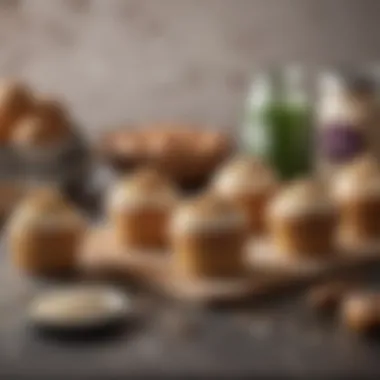
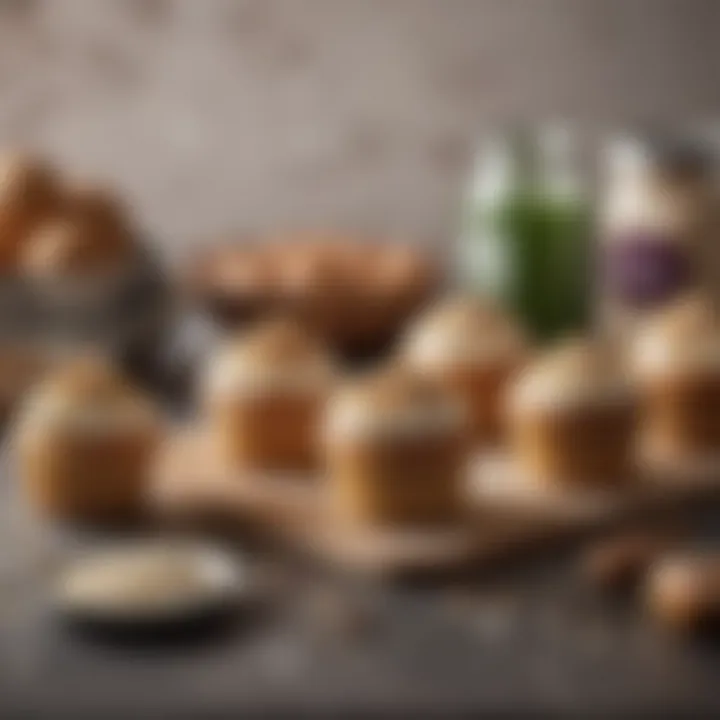
Buttercream frosting stands tall as a staple in the world of sweet toppings. Its creamy texture and rich flavor make it a popular choice among bakers. This frosty delight is made primarily from butter, sugar, and a splash of milk or cream, which gives it that luscious consistency. Perhaps its most glowing charm is its adaptability—easy to flavor and tint, you can whip it into any design you please. The downside, however, can be its tendency to become overly sweet, especially if not balanced properly with other elements of your cupcake.
"A touch of salt can work wonders in mellowing the sweetness of buttercream, bringing out its true flavor."
Alternative Frostings
While buttercream may command a loyal following, alternative frostings are gaining ground for their unique flavors and textures. Options like cream cheese frosting or whipped ganache can provide a tangy or luxurious twist to your classic cupcake. These frostings often incorporate different bases such as cream cheese, mascarpone, or heavy cream, which contribute to their stand-out characteristics. For instance, a cream cheese frosting can perfectly accompany a carrot cake cupcake, creating a delightful balance. However, these alternatives can require a bit more care in handling, especially with temperature sensitivity.
Creative Decorating Techniques
Piping Techniques
The piping technique is where pure artistry comes into play. Mastering this can transform your cupcakes from ordinary to extraordinary in a heartbeat. Whether you choose a star tip, round tip, or basketweave, each shape tells its own story. Piping adds volume and dimension, making each treat look like a crafted work of art. A consideration to keep in mind, though, is the practice required; it often takes a bit of trial and error to perfect the application. But when done right, the visual impact is undeniable, leaving your guests impressed.
Garnishing Ideas
Beyond the frosting, the garnishing of cupcakes can elevate the whole experience. Sprinkles, edible flowers, or chocolate shavings can jazz up the presentation, giving each cupcake its own personality. The key characteristic of garnishing is its ability to add texture and sometimes flavor, enhancing the cupcake's appeal. For instance, a sprinkle of sea salt atop a chocolate cupcake can provide a delightful contrast. However, it is advisable not to overdo it; too many garnishes can detract from the core flavor of the cupcake.
Exploring Cupcake Variations
Exploring variations in cupcake baking can greatly expand the scope of what you can create, making it an essential part of mastering the craft. Different flavors, dietary options, and presentation styles offer bakers the opportunity to cater to diverse palates and occasions. Not all cupcakes need to follow the run-of-the-mill vanilla or chocolate mold; stepping outside the box opens the door to creativity and innovation. This section will delve into various classic and modern cupcake flavors, highlighting techniques and tips to ensure that every bite resonates with taste and originality.
Classic Cupcake Flavors
Classic flavors have remained popular for good reason; they lay the groundwork for familiarity and comfort in baking. Here, we'll examine two key flavors—vanilla and chocolate, as well as the crowd-pleasers red velvet and carrot.
Vanilla and Chocolate
Vanilla and chocolate cupcakes are perhaps the most recognizable in the dessert realm. Their widespread appeal lies in their simplicity. A well-made vanilla cupcake, with its light and airy texture, often serves as the perfect canvas for various frostings and toppings. The classic choice of rich chocolate, with its deep flavor, provides a contrasting experience that many bakers cherish.
The unique feature of these cupcakes is their versatility. For instance, a vanilla base can easily transform into a lemon or almond-infused delight with just a tweak of flavor extracts. Meanwhile, chocolate can embrace richness by incorporating cocoa nibs or dark chocolate chunks.
Anticipated drawbacks include their ubiquity; if you're looking to impress with something new and exciting, you might hesitate to stick with these classics. However, understanding how to elevate these flavors through unique frostings or innovative toppings can make all the difference. At the end of the day, you can never really go wrong with a tried-and-true vanilla or chocolate cupcake.
Red Velvet and Carrot
Red velvet and carrot cupcakes bring a delightful twist to traditional flavors. Red velvet is renowned for its striking color and subtle cocoa undertone, often accompanied by tangy cream cheese frosting. This combination makes it both visually appealing and palatably engaging. A standout feature is its tender crumb, which elevates the overall tasting experience.
Carrot cupcakes, on the other hand, introduce health consciousness into the mix. Often packed with spices and nuts, they boast a hearty texture and can even add a nutritional punch when using whole grains or reducing sugar. The unique aspect of carrot cupcakes is how they combine flavors of cinnamon, nutmeg, and even crushed pineapple for added moisture.
However, depending on the recipe, the texture of carrot cupcakes may vary, with some bakers experiencing overly dense results. Similar to vanilla and chocolate, the popularity of red velvet and carrot flavors can also lead to overindulgence in traditional recipes. Thus, experimenting with alternative ingredients or unique frostings could be beneficial in keeping these classics fresh.
Innovative Flavors for Modern Palates
The modern palate is always seeking new experiences, pushing bakers to explore innovative flavor combinations. In this section, we'll dive into untraditional yet increasingly popular options: matcha and lavender, as well as alcohol-infused cupcakes.
Matcha and Lavender
Matcha and lavender cupcakes embody the essence of contemporary baking. Matcha, a powdered green tea, lends a vibrant green hue and a unique earthy flavor. It’s not just unique in appearance; the health benefits associated with matcha add a modern twist that appeals to health-conscious bakers. The unique taste has made it a worthy contender for those looking to dazzle guests with something unfamiliar.
Lavender, with its beautiful fragrance, creates a delightful contrast, offering an aromatic experience in each bite. The combination of these two flavors opens up doors to limitless add-ins and frostings, allowing for endless creativity while remaining sophisticated.
However, achieving the right balance is crucial. Too much lavender can easily dominate the palate, overshadowing the subtlety of matcha. The quest for the appropriate texture can also be challenging, as both ingredients may necessitate adjustments in moisture and leavening agents.
Alcohol-Infused Options
Alcohol-infused cupcakes represent a growing trend in baking that caters to adult tastes. Flavors like bourbon chocolate or champagne strawberry bring a playful twist to festivities. This kind of infusion creates a rich, unique profile that can elevate the typical cupcake experience.
One of the key characteristics of alcoholic flavors is their ability to evoke emotion and nostalgia, often reminding individuals of past celebrations. This aspect can be particularly beneficial for special occasions, drawing guests’ attention to the spirit of the gathering.
On the downside, the inclusion of alcohol may not be universally appealing, especially to younger audiences or those avoiding alcohol. Moreover, accurately calculating alcohol content without overwhelming the batter requires careful attention.
Cupcakes for Every Occasion
Baking cupcakes isn't just about the sweet treat itself; it's about bringing joy and creating connections through those little morsels of delight. Every occasion, big or small, can be made more special with the inclusion of cupcakes. They can act as the centerpiece for birthdays, weddings, or festive gatherings, weaving their way into the fabric of celebrations. Their versatility makes them perfect for any event, allowing bakers to experiment with flavors, designs, and themes that cater to the desired mood or vibe.
Choosing cupcakes for various occasions doesn't just provide a sweet finish to meals, it also enables bakers to express their creativity and personal flair. With the right decorations and flavors, cupcakes can fit perfectly into any theme, elevating gatherings from ordinary to extraordinary. In this section, we will delve into the delightful world of celebratory cupcakes, seasonal inspirations, and more.
Celebratory Cupcakes
Birthday Themes
When it comes to birthdays, cupcakes serve as more than just a dessert; they embody the spirit of festivity and celebration. One of the standout features of birthday cupcakes is their ability to be customized according to the individual's age, interests, or favorite colors. Whether it’s a superhero theme for a child or an elegant design for an adult, cupcakes can be tailored to match the event.
The unique aspect of birthday cupcakes is their individual serving size, which usually means less mess than cutting a traditional cake. They can easily be placed on a decorative stand, looking vibrant and inviting. Each guest can grab their own without the fuss of slicing cake. They’re convenient, fun, and each cupcake can be a canvas for creativity—from bold sprinkles to elaborate frosting designs. However, one consideration could be the flavor selection; making each one unique might overcomplicate choices during large gatherings.
Weddings and Anniversaries
Weddings and anniversaries hold a special place in the realm of celebrations and cupcake artistry shines here as well. Instead of a towering bride-and-groom cake, many couples are opting for cupcake towers, with each tier adorned with beautifully crafted cupcakes. This trend not only saves on costs but also gives guests greater variety. The focus here is on elegance and personal touch, with cupcake flavors and decorations that reflect the couple’s love story.
These cupcakes can be adorned with delicate floral designs and intricate details that align with the wedding's overall theme. A key characteristic of cupcakes for weddings is their customization. Couples can choose flavors that represent their journey, combine favorite tastes, or even incorporate seasonal ingredients to match the time of year. However, a potential downside might be the need for professional decorators to achieve that desired aesthetic, which could lead to higher expenses.
Seasonal and Holiday Cupcake Ideas
Festive Decorations
Holidays are all about joy and connection, and cupcakes can be the perfect vessel for festive cheer. Seasonal decorations play a significant role in elevating cupcakes as they can transform a simple dessert into a visual feast. Consider red and green sprinkles for Christmas, pastel colors for Easter, or vibrant hues for summer celebrations.
The beauty of festive decorations lies in their ability to invoke memories and emotions associated with specific holidays. They can be personalized, making them a wonderful choice for family gatherings or parties. However, sometimes the effort to create intricate designs could detract from baking time, so balancing creativity with practicality lends itself to a smoother process.
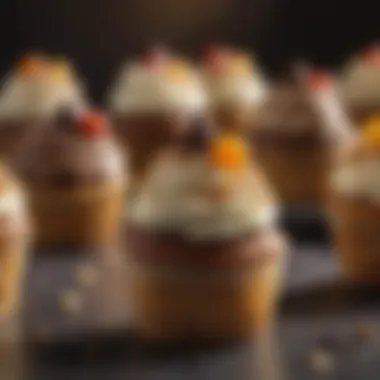
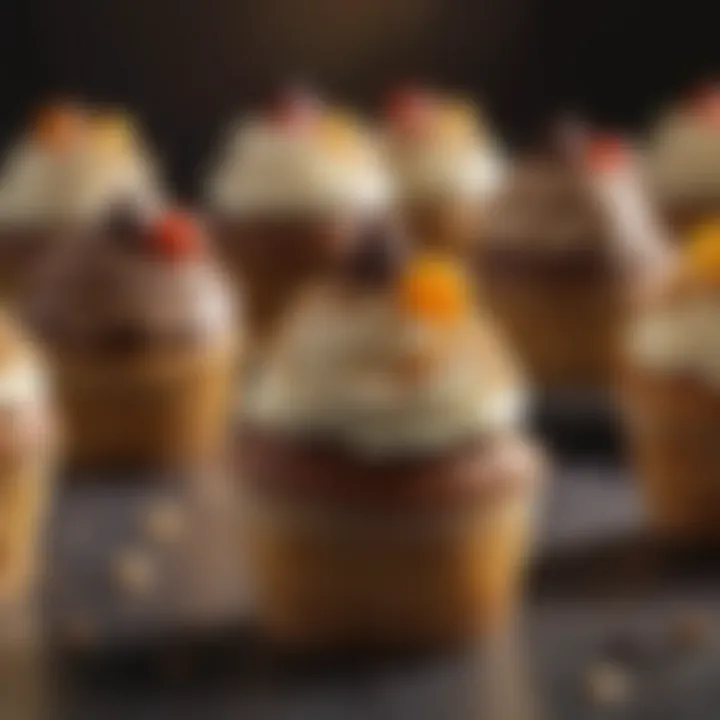
Seasonal Flavors
The changing seasons bring with them an array of flavors that can enhance cupcake baking. Imagine the cozy taste of pumpkin spice in fall or the refreshing zest of lemon-lime in summer. Seasonal flavors contribute not just to taste sensations, but also to the overall experience of the event.
A key aspect of employing seasonal flavors is the opportunity to use fresh, local ingredients that might be at their peak during certain times of the year. This not only boosts flavor but also supports local agricultural businesses. On the downside, being limited to certain ingredients might restrict what you can create, especially if you have a broader palate in mind.
Embracing cupcakes for every occasion brings creativity, joy, and a personal touch to celebrations, ensuring that no event goes by without a hint of sweetness.
Troubleshooting Common Issues
Baking cupcakes is a delightful endeavor, yet even seasoned bakers sometimes face hurdles. Understanding common issues and how to address them is pivotal for achieving that perfect cupcake. This section delves into some typical problems and offers solutions, ensuring you can bounce back from any baking missteps.
Overcoming Baking Failures
Baking failures can be disheartening, particularly when efforts seem in vain. Knowing how to identify and rectify these issues lays a solid foundation for future success.
Flat or Sunken Cupcakes
Flat or sunken cupcakes are a common vexation for bakers. The key characteristic of this issue often springs from inadequate leavening agents or incorrect oven temperature. For instance, using old baking powder can significantly diminish its effectiveness, thus leading to disappointing results.
Having a well-risen cupcake is not just about aesthetics; it also affects the texture and overall enjoyment. A flat cupcake might taste just fine, but it lacks the fluffiness that many associate with an enjoyable treat.
In this article, it’s imperative to highlight that tackling the problem begins with understanding the need for freshness in your ingredients. Using reliable brands and checking expiration dates can save a day. Another significant factor is the oven temperature. If there's a fluctuation in heat or it’s too low, your cupcakes could end up like sad little pancakes instead of lofty mouthfuls of joy.
Texture Problems
Texture problems can manifest as rubbery, dense, or dry cupcakes – an all too familiar nightmare. These issues generally stem from improper mixing techniques, overmixing or undermixing the batter can lead to undesirable results. The key component here is the mixing method. When you overmix, gluten develops, making your cupcakes tough rather than tender.
The unique feature of texture issues is that they can often be mitigated by following recipes closely and understanding ingredient functions. For example, incorporating dry and wet components in alternating batches helps maintain a lighter batter, ultimately leading to a fluffier outcome. Notably, achieving the right baking time is crucial too; pulling your cupcakes out just before a toothpick comes out clean can spare you from drying them out.
Adjusting Recipes for Desired Outcomes
Fine-tuning your recipes is something each baker should feel confident to tackle. Recipes are guidelines, and sometimes you might want to tweak them based on personal preferences or ingredient availability. Want cupcakes a bit denser? Consider changing the flour type or fat ratio. Craving more sweetness? A tablespoon or two of additional sugar could do the trick.
Here are some key adjustments to consider:
- Flour Substitutions: For a heartier texture, swapping some all-purpose flour with almond or coconut flour adds dimension.
- Egg Variations: If you're out of eggs, unsweetened applesauce works surprisingly well as a replacement.
- Sweetener Choices: Experimenting with honey or maple syrup instead of granulated sugar can offer a pleasant twist.
- Flavor Enhancements: Don’t be shy about throwing in spices; a pinch of cinnamon or nutmeg can elevate a basic cupcake into something remarkable.
"Baking is a science, but it is also an art. Feel free to adjust and experiment, and don’t fear failure. Each stumble strengthens your expertise."
In the realm of making delightful cupcakes, treating recipes as flexible frameworks encourages creativity and individuality. Rest assured that with practice and a touch of intuition, your cupcakes will not just taste delightful but also reflect your personal flair.
Time-Saving Tips for Busy Bakers
Baking cupcakes can be a joyous endeavor, yet it can also turn into a time-consuming task, especially for those juggling numerous responsibilities. Understanding time-saving tips is crucial for busy bakers who want to enjoy the thrill of cupcake creation without losing valuable time. These strategies can streamline the baking process, making it more efficient and manageable.
Batch Baking Strategies
A smart way to cut down on baking time is batch baking. This approach involves preparing multiple batches of cupcakes in one go. Not only does this save time, but it also allows you to have an array of cupcakes on hand for different occasions or simply for personal enjoyment. Here are some tips to get you started:
- Plan Ahead: Write a list of cupcake flavors you want to bake. This way, you can gather all your ingredients and tools beforehand.
- Double or Triple Recipes: If a recipe yields a dozen cupcakes, consider doubling or tripling the batch. Use a large mixing bowl to accommodate the increased volume.
- Utilize Freezing: Cupcakes freeze well without losing their moisture and flavor. Bake a big batch, frost a few, and store the rest unfrosted. You can thaw them as needed for last-minute desserts.
Utilizing Kitchen Tools Efficiently
Having the right kitchen tools can immensely simplify the baking process, allowing bakers to work smarter, not harder.
Useful Gadgets
When it comes to useful gadgets, a manual or electric whisk can save both energy and time. A stand mixer is particularly popular among bakers for several reasons:
- Efficiency: A stand mixer does the mixing for you, which is a huge time-saver, especially when working with thicker batters. It frees up your hands for other tasks.
- Versatility: Many models come with various attachments, allowing you to not only mix but also knead dough or whip cream.
- Less Effort: Compared to hand mixers, stand mixers allow you to multitask, whether it’s lining cupcake tins or preparing toppings while it mixes.
However, they can take up quite a bit of space on your countertop and can be costly. So it’s something to consider based on your baking frequency and kitchen layout.
Organizing Your Kitchen
An organized kitchen is a baker’s best friend. Having your workspace neat and orderly can save time and reduce stress during the baking process. Here are a few tips:
- Labeling: Use clear labels on containers for your flour, sugar, and other ingredients. This helps avoid fumbling through mismatched bags looking for what you need.
- Grouping Tools: Keep frequently used tools, such as spatulas, measuring cups, and muffin trays, in easily accessible drawers or containers. This can cut down the time spent looking for what you need.
- Creating a Baking Zone: Designate a specific area in your kitchen for baking. This will keep all related items in grasp and tauten your efficiency.
Overall, implementing time-saving tips is about maximizing efficiency without compromising on quality. By adopting batch baking and utilizing your kitchen tools effectively, even the busiest bakers can whip up delightful cupcakes while managing their time wisely.
"Good organization and strategic planning can turn your baking experience from chaos to calm in no time."
Embrace these strategies, and you’ll find that your love for baking cupcakes can thrive even on the busiest of days.
Culmination
Baking cupcakes is far more than just mixing ingredients and throwing them in the oven. It's a meditative dance of flavors, techniques, and creativity that beckons both novice and seasoned bakers alike. This section of the article helps encapsulate the importance of embracing the art of cupcake baking, emphasizing key elements that lead to delightful outcomes.
Embracing the Joy of Cupcake Baking
Baking cupcakes should be approached with a genuine sense of joy and curiosity—it offers an avenue to express one's culinary artistry. The tactile process of blending ingredients, the sweet aroma wafting from the oven, and the vibrant colors of a decorated cupcake can evoke a sense of fulfillment that goes beyond mere consumption.
- Therapeutic Nature: There's undeniable therapeutic value in this process. Kneading, mixing, and decorating let bakers step away from life's complexities, fading troubles to the background.
- Personalization: Every baker can make their cupcake unique, be it in flavor or decoration, allowing for personal expression. Whether it's a hint of spice or a playful topping, each decision becomes an extension of one’s personality.
- Sharing and Bonding: Creating cupcakes can also act as a bridge to connection. As you share your baked goods with friends or family, you nourish relationships, oftentimes sparking conversations and creating lasting memories.
"Baking cupcakes is like crafting small pieces of happiness; each bite carries the warmth of creativity and devotion."
Encouragement for Continued Exploration
As we've traversed through the nuances of cupcake baking, it's vital to encourage culinary enthusiasts to keep exploring. The world of baking is expansive, with countless flavors and techniques beckoning to be discovered.
- Experimentation: Don't shy away from trying out new ingredients, such as unique spices or alternative flours. The more adventurous you get, the more rewarding the outcome can be. Imagine turning a traditional vanilla cupcake with a sprinkle of cardamom or a decadent chocolate number into an instant showstopper.
- Learn from Others: Engaging in communities could greatly enrich your journey. Platforms like Reddit provide a treasure trove of tips or troubleshooting advice from fellow bakers. Share your tales, seek advice, or simply bask in the collective knowledge available.
- Keep Upskilling: Baking is an ever-evolving craft. Attend local workshops or follow online tutorials to enhance your skills—it's both educational and fun. Every new skill adds to your toolbox, making you a more versatile baker.
In summary, the journey into cupcake baking is a continuous process of learning, creating, and sharing. By diving deeper into its layers and flavors, one can create memorable and delightful culinary experiences for themselves and those around them.







